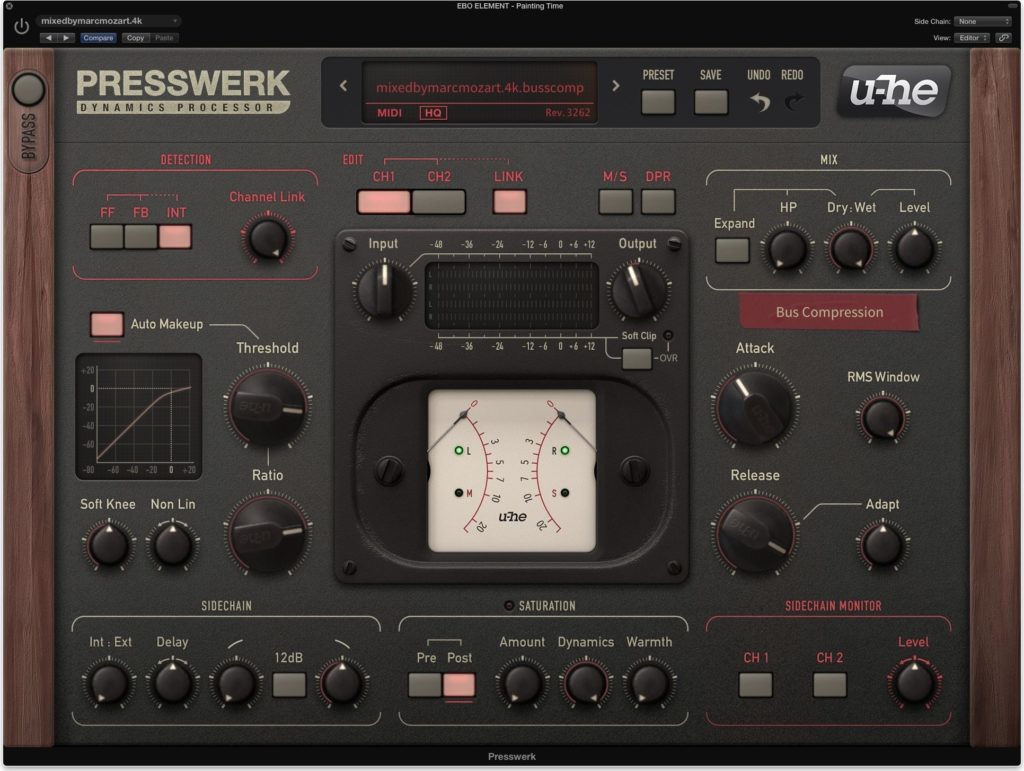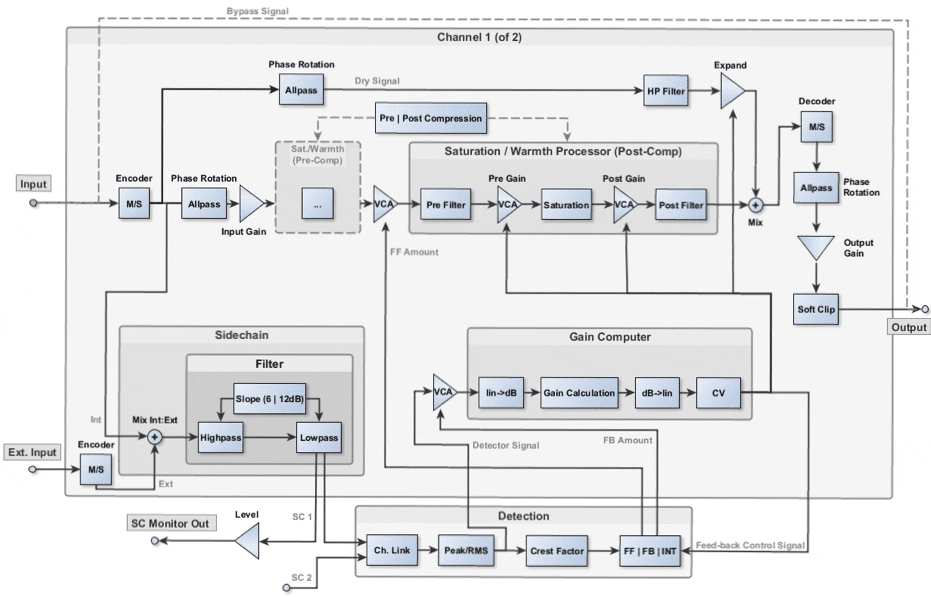In a previous post on compression, I looked into using compressors as „toneboxes“, and put a few classic compressor emulations through a test setup that would make their harmonic distortion visible, using a test oscillator and frequency analyzer.
A number of readers immediately asked me to share my opinion on the beta-version of u-he’s PRESSWERK, a new plug-in the manufacturer dubs as „uber-compressor construction kit“.
After months of public beta-testing the compressor plug-in has just been released, and this review is giving you a first look at the finished product.

Basics
Berlin-based company u-he, named after it’s founder Urs Heckmann, is a boutique developer of audio plug-ins. I’m sure many of you have heard of u-he’s instruments DIVA and ZEBRA, synthesizer plug-ins that are highly rated amongst my producer-friends in electronic genres.
As far as I know it’s their first foray into compression territory, but of course their fine reputation in analogue circuit emulations had me expect something new and unique, manufactured to the highest standards of a boutique german engineering team. Let’s not forget they are the guys behind the SATIN TAPE MACHINE, one of the finest Tape Simulation and Tape Effects plugins on the market.
PRESSWERK is available in all major plugin formats (AU, VST2, AAX) for both Mac OS X and Windows, and even delivers full compatibility with both 32 and 64bit applications (something most plug-in developers failed to achieve).
Download and installation took less than 2 minutes. The download folder comes with a very detailed PDF user manual that gives a lot of valuable background information on the philosophies behind the various building blocks.
The Look
The first thing that came to my mind was that despite a total of 38 controls on the GUI, PRESSWERK didn’t overwhelm me with the number of controls – it looks very accessible.
Thats partly thanks to PRESSWERKs huge default size on the screen (about 1/6th on my 30“ Apple Cinema HD Display), and a lot of considerations went into the GUI-design.
During the public beta-test, GUI elements and features were added and removed again, and this final release version feels very solid in that respect. I really like the beautiful VU-meters placed in the center of the plug-in, and there is a hardware feel to the various controls of PRESSWERK.
BTW, the size of the GUI can be adjusted in 10%-steps, from 672 x 462 to 1920 x 1320 pixels. Even the brightness of the GUI can be adjusted in 5 steps, just one of many little useful details.
Building Blocks
If you look at the block diagram, you will see that PRESSWERK unites all the features and topologies found in classic 1950 – 1970 compressors, while giving the user full control over these features and clear labels to access these in detail.
I can see PRESSWERK becoming popular in audio schools, as there’s no other plug-in that will make it that easy to educate someone about the details of ALL vintage compressors in one plug-in.

How does it sound?
First thing I did was load the template of my recent article on compression and harmonics, and take a quick look at the spectrums PRESSWERK generates when you feed it with sine-tones of various levels.
That of course put my attention immediately to the „saturation“-section of the plug-in.

All of the emulations I’ve tested in my previous article, except one, generated harmonic distortion, and these would usually increase in level the more gain reduction (= compression) you’re applying.
With PRESSWERK, you have total control over the amount of harmonics that are added, and the DYNAMICS-control can seamlessly adjust between „depending on the volume of the source material“, and „harmonics always added“.
The basic harmonics added look somewhat similar to these of a classic UREI 1176 blue stripe, but the various controls of PRESSWERK’s saturation section can highly customize them, for example apply them either PRE or POST compression, statically or following the dynamics of the material, and you can also balance the spectrum of the harmonics slightly using the COLOR-control which is essentially a „tilt“-type filter/EQ.
When you watch the clip, pay attention at me playing with the Saturation-section of PRESSWERK starting at around 1:11min.
Bus Compression
To further explore the possibilities, I loaded a recent mix I’ve finished, in a version that had no bus compression applied.
It quickly became clear that PRESSWERK is offering a wide variety of tones and possibilities as opposed to being a one-trick pony that does just one thing (like many of the plugins that emulate classic gear).
Working with PRESSWERK is always a playful dialling of parameters until you find what you are looking for – and usually that only takes a few seconds.
Just out of interest I’ve imported the mix in a version that has the Bus Compression of my analogue 4000G console printed on it, and reversed the phase. That way, If I could manage to create silence at the output, PRESSWERK would emulate the characteristic of my hardware.
After setting Ratio-, Attack- and Release-values similar to my SSL, it took me about a minute of finetuning the Threshold-, Input- and Output-levels to get a cancellation of around 15dB. That is very close!
Here’s a clip playing back the mix I used for the test. It starts with the compressor bypassed, and I switch in PRESSWERK as a gentle bus compressor at around 0:14 seconds.
BTW, thanks to south-african duo EBO ELEMENTS to let me use their song for this review. I love their music, and you should check out their EP (which I’ve mixed) and add them on Facebook.
In regards to buss compression, PRESSWERK delivers the entire range, from subtle to extreme, and I can see it being used in mastering as well.
Part 1 Conclusions
I didn’t originally plan to make this a 2-Part review, but PRESSWERK has so much more in store that needs to be explored, and I’ll be back with that shortly, looking into compressing vocals, bass, kick, and using the side chain.
Of course, I’m not ending this first part without an answer to the essential question…
Would I recommend PRESSWERK?
Quality
Top-notch, which had to be expected by one of the premiere developers of analogue synthesizers. PRESSWERK is another showcase of u-he’s expertise in digital modelling of analogue circuits.
Ease of use vs. Versatility
u-he have found the sweetspot between features and ease of use. 30 years have passed since I first used a compressor – but I still learned a few new things playing with PRESSWERK.
At the same time, you can be a newbie to audio, and still get good results in almost no time.
Price
PRESSWERK is $129. Given the wide range of possible applications, I think it’s a no-brainer.
Unless perhaps you already own about 50 vintage compressor emulations by top developers, for which you probably paid several thousand Euros/Dollars.
Go and get it… u-he PRESSWERK website & store
BTW, if you’re interested in the test-setup from the first clip, and you use Logic Pro X, subscribe to my email newsletter and I’ll send you the link.










